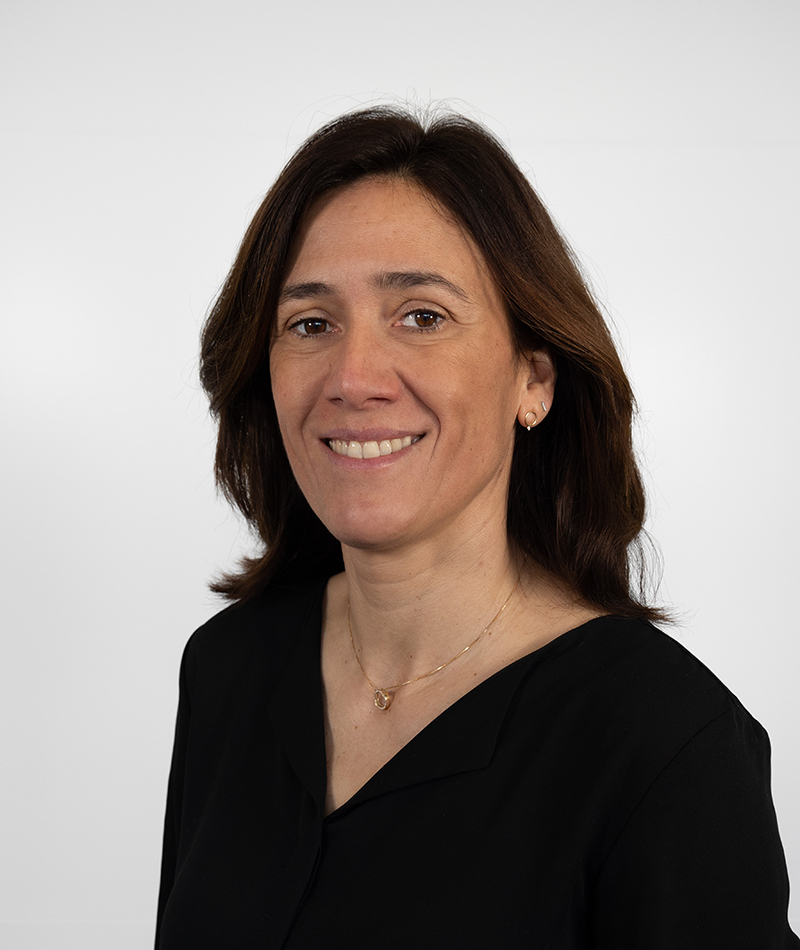
Navigation & Positioning (N&P)
Director of Institutional Relations & Communication
Email: monica.navarro@cttc.catPhone: +34 936 452 900
Monica Navarro holds a MSc degree in Telecommunications Engineering from Universitat Politècnica de Catalunya (1997) and a PhD degree in Telecommunications from the Institute for Telecommunications Research (ITR), University of South Australia (2002).
She is the Head of the Communication Systems Division of the Centre Tecnològic de Telecomunicacions de Catalunya (CTTC), where she also holds a Senior Researcher position within the Statistical Inference Department for Communications and Positioning, of the Communication Systems Division. She is a Senior Member of the IEEE.
Prior to joining CTTC, she participated in the Cooperative Research Centre for Satellite Systems (CRCSS) and Mobility Wireless Data Consortium, Nortel Networks, while pursuing her Ph.D. degree at ITR. From Oct. 1997 – Dec. 1998 she was a Research Assistant at the Department of Signal Theory and Communications at the UPC, where she worked on the pioneer development of fractal shape multiband antennas for wireless cellular communications systems.
She has also been part-time lecturer at the Universitat Pompeu Fabra, Barcelona, where she taught undergraduate courses on communications theory and channel coding, as well as an advanced course on mobile communications.
During her research and management activities at CTTC, she has led and/or promoted projects funded by the European Commission, Spanish and Catalan Governments, as well as the European Space Agency (ESA), spanning across 3G to 5G air interface designs, modem prototypes for space applications, virtualized wireless networks, accurate radio based positioning and intelligent transport systems. As part of her duties as Head of Division she is responsible for the definition of the Strategic and Functional Plan for the Division, which establishes the Division mid/long-term research lines and strategies, including equipment, laboratories and testbeds and human-resources planning.
Her primary areas of interest are on digital communications and information processing with applications to wireless communications and positioning. Including contributions to wireless link and access layer procedures, coding/decoding techniques applied to channel coding systems and network coding schemes, iterative information processing applied to synchronization, demodulation and decoding, non-orthogonal solutions for multiuser and multiple access protocols in wireless and satellite scenarios, machine/deep-learning for wireless communications radio interface design, and positioning/localization and tracking algorithms based on radio technologies.
She has actively participated over more than 25 projects spanning from competitive European and National funds to direct contracts with industry. Among her most relevant contributions are her leading role as technical manager of the European Space Agency project “Coupled enhanced Turbo codes demodulator and decoder study” (COUPLEDETC), and its counterpart which she promoted “Next Generation Uplink Coding Techniques” (NEXCODE), which addressed challenging communication problems for deep-space and their impact on the telemetry and telecommand protocols as well as on the transceivers’ architecture. As outcome of this work, a patent on frame synchronization was filed where she is a co-inventor. A technical recommendation on the start sequence design and detection was also presented at the Consultative Committee for Space Data Systems (CCSDS), which later adopted as part of the standard new sequence lengths to improve the start sequence detection. Other examples where she has led CTTC’s contribution in coordinated projects are: the European 5GPPP project FANTASTIC-5G which developed a new multi-service Air Interface for 5G networks below 6 GHz; the H2020 VITRO which established some of the early solutions for network virtualization, developing the VITRO architecture for federated Wireless Sensor Islands. The work performed in the National CENIT project on Active demand side management applied to the Electric Power Grid provided her and the group relevant expertise on the management of the electric grid that were latter exploited to attract funding from other Smart Grid projects. As principal investigator of the ULTRA-RED project, she helped to stablish a line of research on UWB communications and positioning, which have been evolving from communication and medical applications to enhanced safety in vehicles and enabling technology for Intelligent Transport Systems. As representatives examples for international networking and fostering excellence between research groups in Europe and training, are her contribution to the European Network of Excellence “Antenna Center of Excellence” (ACE and ACE II) where the European School of Antennas was originated, and which has been successfully running on self-funds over more than 12 years. More recently she had a leading role at consortium level in the preparation of H2020 Marie Skłodowska-Curie Innovative Training Networks (ITNs), which was successfully funded through WindMill European Training Network (ETN) project, and where she is part of the management as co-chair of the Supervisory Board. She has particularly supported and encouraged the group initiatives for acquiring and developing expertise on machine learning for its application to wireless communication framework at its incipient stage -well complementing the strong expertise on statistical inference and information processing of the team- which has led to a significant number of attracted funds on the topic.
At the scientific level she has published over 65 journals/magazines and international conference papers. Details can be found at CTTC’s publication site and ORCID.
She has also contributed to knowledge dissemination with the publication of 6 book chapters on the areas of channel coding, cross-layer designs and link adaptation for multicarrier system, UWB systems and radio based UWB positioning and distributed algorithms for demand management in Smart Grids.
She regularly serves as TPC of international conferences such as IEEE Globecom, IEEE ICC, IEEE WCNC, IEEE ICUWB, IEEE ITSC or EUSIPCO, where she served as member of the organization committee in its 2011 edition. She has organized 3 special sessions/workshops and chair 5 technical sessions at international conferences. She is a regular reviewer of several IEEE journals on the topics of communications and localization. From 2013 to 2016 she was served as member of the Editorial Board ETT Emerging Telecommunications Technologies and has been Guest Editor of EURASIP Journal on Wireless Communications and Networking and Journal on Signal Processing.
In addition to scientific and academic forums she has also participated in industrial events and expert groups such as the Think Tank #Vehicles7YFN (www.vehicles7yfn.com), where she has actively participated since the creation of the initiative by AMETIC (https://ametic.es), to devise strategies and anticipate scenarios for autonomous, connected, and sustainable mobility in Europe. She is also a member of AMETIC’s Comisión de Vehículo Conectado y Movilidad Sostenible, with strong industrial participation. Within the 5G Barcelona initiative, she has participated in several workshops focused on fostering the early adoption of 5G, the identification of relevant use cases and joint technological development with CTTC contribution. In this context, she leads the technical contribution on hybrid positioning solutions for enhanced vehicle safety in two pilot demonstrations.
In the area of space communications, as a result of the NEXCODE project, she actively participated on the “Space link coding & synchronization working group” (SLS-C&S) of the CCSDS.
Besides the technology transfer conveyed through her participation in industrial projects she also has contributed to CTTC’s IPR portfolio with 3 patents (on synchronization and demodulation in UltraWideband systems, and frame synchronization in communication systems) and one additional IPR contribution on hybrid sensor fusion positioning solutions and prototype.
She has been a regular lecturer at the European School of Antennas (ESoA) on the postgraduate courses “Cooperative Communications and Distributed Antenna Arrays”, “Wireless Networks: From Energy Harvesting to Information Processing” and “Energy Harvesting and Wireless Power Transfer for RFIDs and Wireless Sensor Networks”. She taught Cooperative Communications at its 2006, 2009 and 2013 editions and Information processing and communication theory at its 2015 and 2018 editions. From 2010 to 2017 she was the course coordinator and ESoA board member. The course was equivalent to 3 ECTs from a PhD program, which involved one week programme including theoretical classes and practical assignments, with a final evaluation exercise. Her teaching experience includes as well on-demand courses for the industry (e.g. MIMO for Power Line Communications), undergraduate courses (e.g. Communication Theory and Wireless Communications at Universitat Pompeu Fabra) and tutorials in more technical fora (e.g. “Cooperative Positioning for Real Time Location Systems (RTLS)”, invited tutorial to the Joint Seminar WIBEC/COST-IRACON on Radio frequency Localisation Techniques, 29 May 2018, Cartagena, Spain).
Besides teaching, she is actively contributing to the training of undergraduates, graduates, and postgraduates through the supervision of Bachelor and Master thesis (8) and PhD thesis (in progress).
Other services and merits
She has contributed to the Strategic Research Agenda of European Work Programmes.
Reviewer for the Spanish National Research Program.
Participation in PhD thesis evaluation committees.
She was recipient of the 2007 Internet Global Congress (IGC) prize to Digital Innovation in the category of Universities and Institutions R&D to the project “m:Ciudad” (http://www.igcweb.net/).
ORCID ID: https://orcid.org/0000-0002-9708-5877
MISCELLANEOUS
Thesis
- M. Navarro, Receive and Transmit Strategies for Multiple Antenna Systems, PhD thesis, University of South Australia, 2002.
- M. Navarro, Application of Several Modifications to the Sierpinski Antenna, Multiband Fractal Antenna (in Catalan), PFC thesis, Univeristat Politècnica de Catalunya, 1997.
